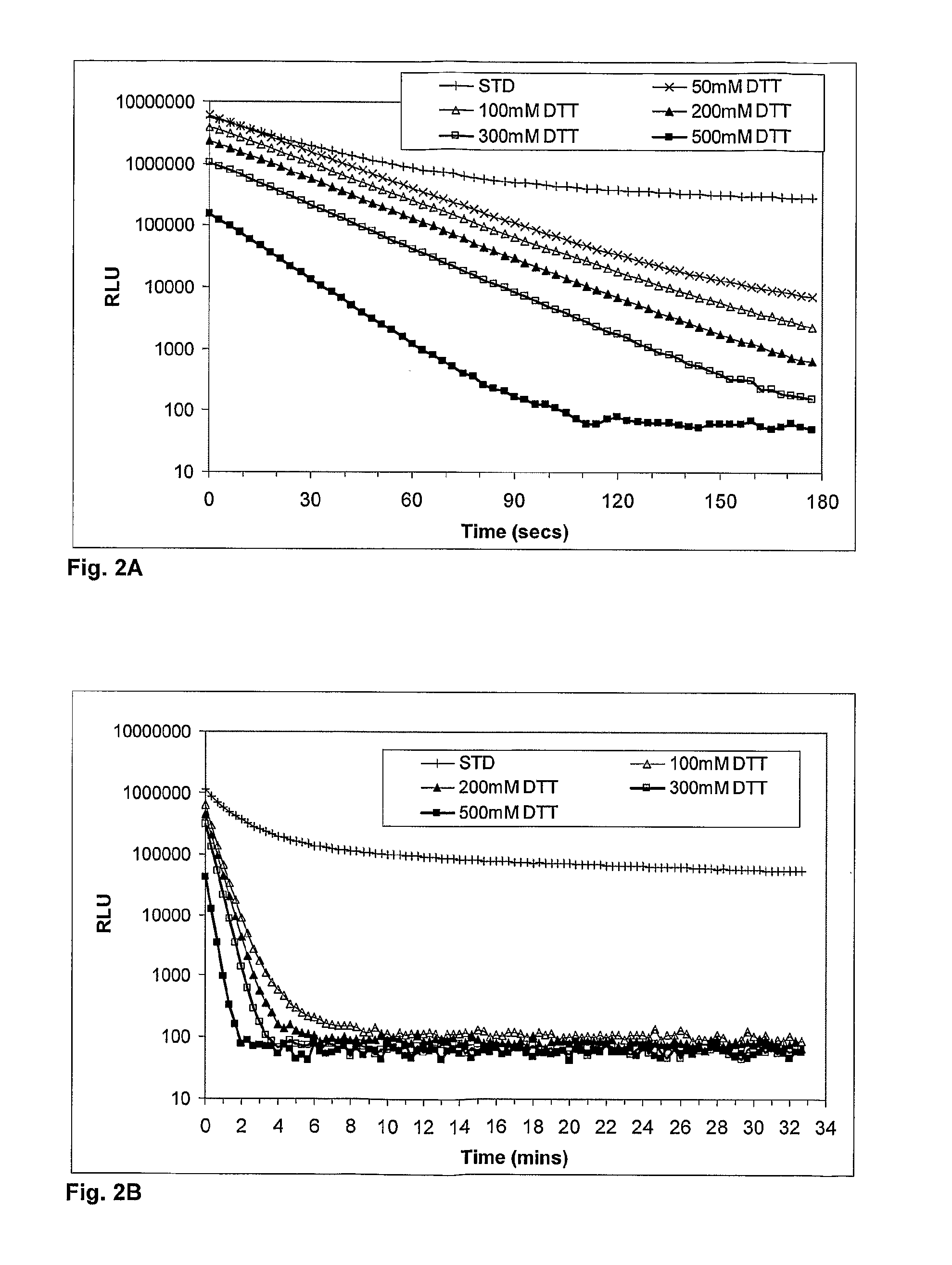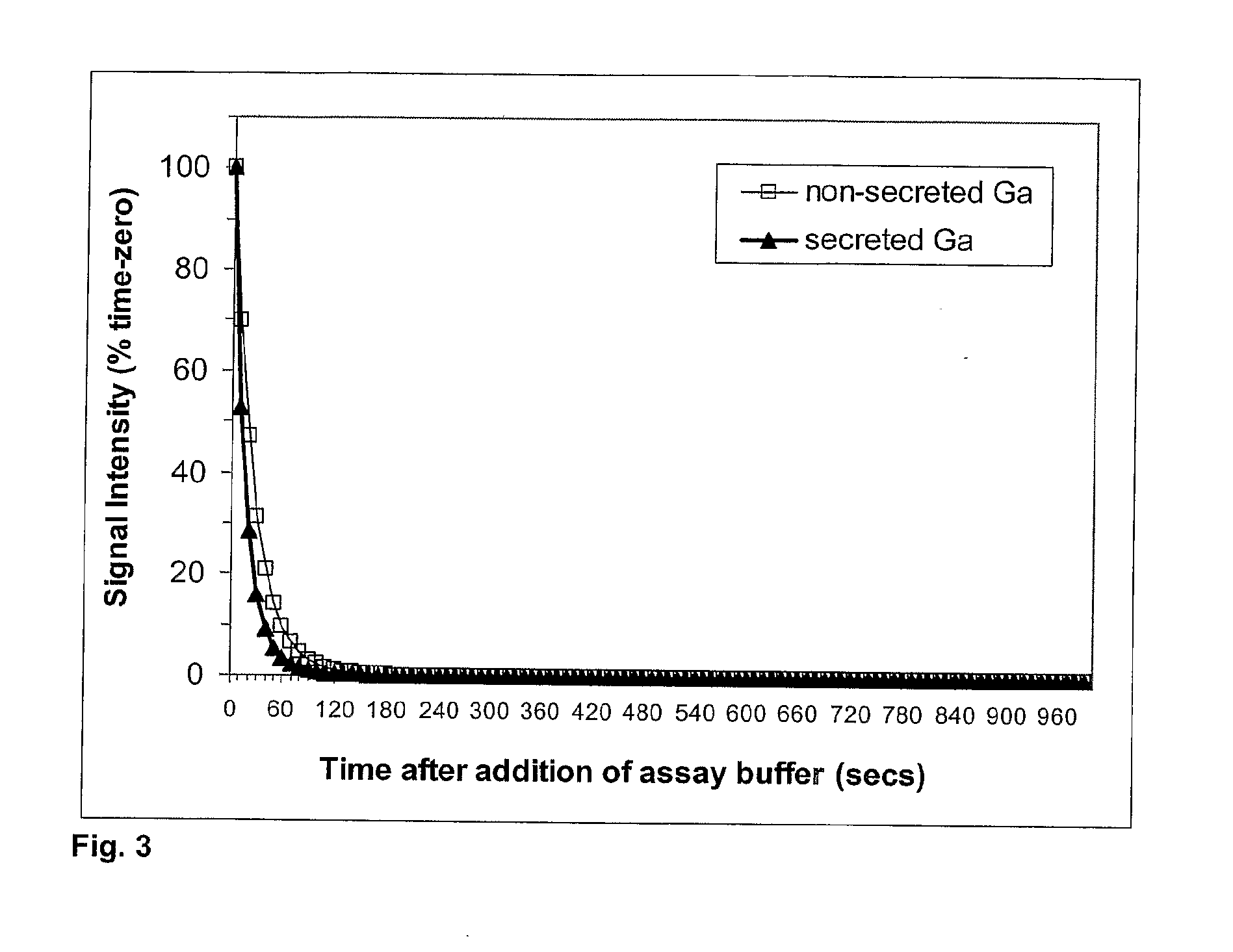Bioluminescent assays utilising secreted luciferases
- Summary
- Abstract
- Description
- Claims
- Application Information
AI Technical Summary
Benefits of technology
Problems solved by technology
Method used
Image
Examples
example 1
[0210]HeLa cells stably expressing non-secreted and destabilized Gaussia luciferase were plated onto 96-well plates and incubated overnight. The non-secreted luciferase is a modified Gaussia luciferase in which the 14 amino acid N-terminal signal peptide has been deleted. The destabilised luciferase is an enzyme containing a destabilising element such that it has a shortened half-life and is expressed at lower steady-state level than in the absence of the destabilising element.
[0211]Following the overnight incubation, medium was removed and the cells lysed in 20 ul lysis buffer comprising 25 mM Tris pH 8.1, 150 mM NaBr, 1 mM EDTA, 63.4 uM sodium oxalate, 0.1% NP40 substitute, 5% glycerol (GSv3). Luciferase activity was measured in a kinetic assay following injection of 60 ul of an assay buffer comprising 25 mM Tris pH 8.1; 1 mM EDTA, 2 mM Ascorbate and 26 uM Cz (STD), or the same assay buffer but also containing a reducing agent. Various concentrations of three reducing agents were ...
example 2
[0212]Similar experiments were performed as described in Example 1, however using a broader range of concentrations of DTT in the assay buffer (50 mM to 500 mM). Results from two independent experiments are shown in FIG. 2, representing a short time-course (FIG. 2A) and a longer time-course (FIG. 2B). As observed in the experiments described in Example 1, the rate of decay in luminescent signal was directly related to the concentration of OTT. This effect was seen up to the maximum concentration of 500 mM (FIG. 2A). In the longer time-course (FIG. 2B) the signal dropped to approximately background levels (˜100 RLU) within 10 minutes of initiation at all concentrations. This represents a decrease in light intensity of 1,000 to 10,000 times. Importantly, the observation that DTT shortens the period of light emission from Gaussia luciferase is contrary to that reported for intracellular luciferases, including firefly and other Coleoptera luciferases and Renilla luciferases.
example 3
[0213]Similar experiments were performed as described in Example 1 with the exception that the effect of DTT on the time course of luminescence was also investigated for the wild-type secreted Gaussia luciferase. This was achieved by transiently transfecting HeLa cells with a reporter plasmid encoding the wild-type Gaussia luciferase protein and harvesting the conditioned medium 24 hrs later. The assay buffer (with either 50 mM DTT or no DTT) was injected into wells containing 20 ul of the conditioned medium. Results were expressed as the % signal remaining compared to time zero (see FIG. 3). The data confirm that both forms of the Gaussia luciferase (native secreted and modified non-secreted) yield a very rapid decline in light emission when DTT is included in the assay buffer.
PUM
| Property | Measurement | Unit |
|---|---|---|
| Catalytic activity | aaaaa | aaaaa |
| Wavelength | aaaaa | aaaaa |
| Luminescence | aaaaa | aaaaa |
Abstract
Description
Claims
Application Information
 Login to View More
Login to View More - R&D
- Intellectual Property
- Life Sciences
- Materials
- Tech Scout
- Unparalleled Data Quality
- Higher Quality Content
- 60% Fewer Hallucinations
Browse by: Latest US Patents, China's latest patents, Technical Efficacy Thesaurus, Application Domain, Technology Topic, Popular Technical Reports.
© 2025 PatSnap. All rights reserved.Legal|Privacy policy|Modern Slavery Act Transparency Statement|Sitemap|About US| Contact US: help@patsnap.com



